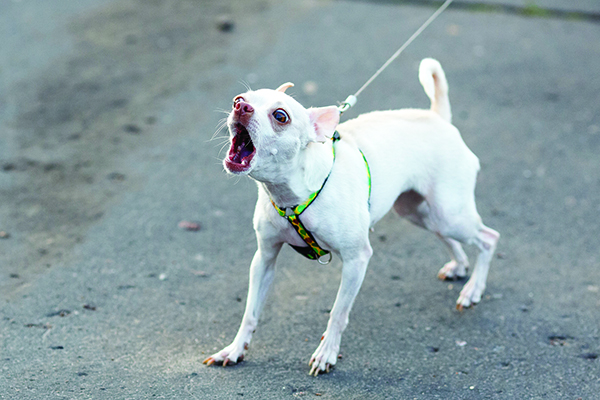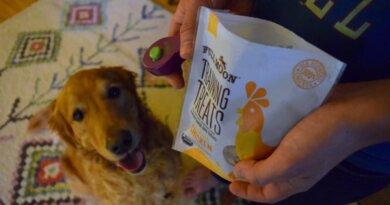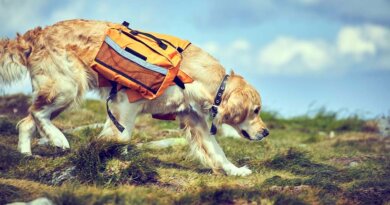Reactive Dog Behavior – Whole Dog Journal
[ad_1]

Reactivity is a commonly used term in the dog behavior and training world, but it’s frowned upon by some in our profession because it’s a somewhat nebulous behavioral descriptor. The word “reactive” gets used to describe everything from the dog who barks a few times when the doorbell rings to the dog who turns into a raving lunatic in the presence of her triggers.
Here’s the best definition I’ve heard: A reactive dog is one with an abnormal level of arousal in response to a normal stimulus. Thus, the dog who barks a few times at the doorbell would not be considered reactive, but the dog who barks excessively at the sight of another dog, a non-threatening human, a passing vehicle, or any other stimulus that causes a significant overreaction, would be. It doesn’t have to be extreme to be considered reactivity – just “abnormal.”
While many owners are capable of dealing with a dog who displays a low to moderate level of reactivity, dogs who display high levels of arousal can be daunting even to experienced dog lovers. It can be disappointing to discover that your dog’s level of reactive behavior is beyond – or even far beyond – what you were prepared to cope with. The good news is we can usually help these dogs learn how to be behaviorally appropriate in the presence of their triggers.
TYPES OF REACTIVE BEHAVIOR
There are two distinctly different types of reactive behavior. One is caused by fear or anxiety and commonly includes a significant risk of aggression. This usually presents in dogs who were not well-socialized, who are generally fearful or anxious, and/or who have perhaps had life events, whether accidental or deliberately abusive, that now cause them to be particularly sensitive to the stimuli that are triggering their abnormal levels of arousal.
The other type is caused by frustration. An example would be the dog who is very eager to interact with the other stimulus – often another dog – but is thwarted from doing so by a leash, fence, other barrier, or physical restraint by a human.
These dogs will often run up to the object of their attention and happily engage in appropriate interaction if released from restraint – but not always. Sometimes the intensity of their frustration has already pushed them over their own threshold to the point they will aggress if released and allowed to interact. Other times, the object of their emotional display may feel threatened by their aroused behavior and react with defensive aggression when approached.
In either case, it’s important for a dog with reactive behavior to learn more appropriate responses. The following suggestions can help you modify your dog’s behavior in the presence of a variety of stimuli that trigger an inappropriately aroused response.
MANAGING REACTIVITY

Management is a critical piece of most (if not all!) behavior-modification programs. Reactivity is no exception. If you want to change your dog’s reactive behavior, she needs to stop practicing it.
Each time a dog reacting from anxiety or fear goes over threshold and the stimulus moves away, the reactive behavior is reinforced, making it more likely to happen again the next time. Although in many cases the stimulus (dog, person, vehicle) would have gone away anyway, the dog doesn’t know this. She thinks growling, barking, and lunging made it go away and thus believes this is a successful survival strategy. Her reactive behavior is likely to repeat or increase as a result.
With frustration reactivity, the motivation is different – the dog wants to go see the other dog, human, etc., and the arousal results from being thwarted. This behavior can result from routinely allowing your dog to greet other dogs and humans while on leash – one of the reasons I strongly recommend against this practice. When your dog expects to be able to greet and for some reason is not allowed to do so, it can result in reactive arousal, especially for dogs who are already struggling with low tolerance for frustration. I ask my dogs to be attentive to me in the presence of others, and they are allowed to greet only on occasion (not every time!) when they are given permission.
If you quickly allow your dog to approach on leash to ease her frustration reactivity, you have positively reinforced her for her behavior: The inappropriate behavior made a good thing happen – she got to visit the other dog. Once again, the arousal behavior is likely to increase as a result.
With both types of reactivity, management means preventing your dog’s over-threshold exposure to the trigger stimuli. In order to do this, you need to have an understanding of “intensity of stimulus” – meaning how close, how active, how loud or what gender the person is; how fast or loud the vehicle is; how large, what breed, color, gender the dog; or any other identifiable quality that will set your dog off.
Your dog might be calm in the presence of any dog if they are at least 50 feet away, with small dogs at least 25 feet away, and specifically with Pomeranians as close as 10 feet. She might be comfortable with women at any distance unless they are wearing a hat, sunglasses, or carrying an umbrella, but all men need to be at least 40 feet away. Your dog might be calm with a person walking outside past your living room window, but a jogger or skateboard sets her off every time.
The better you are at identifying all the various characteristics of all your dog’s triggers and keeping them at below-threshold intensity, the more she’ll stay below her reactivity threshold, and the more successful you’ll be at modifying the behavior.
Please note that in cases with more extreme levels of arousal, appropriate medication can be an important part of management. Discuss this possibility with your veterinarian; ask for a referral to a veterinary behaviorist if she isn’t knowledgeable about behavior-modifying medications.
MODIFYING REACTIVITY

There are several protocols that can be used to manage and modify reactive behavior, and some of them can be used in conjunction with each other. These are the ones I have found most useful, both for effectiveness and ease of use:
* Counter-Conditioning and Desensitization (CC&D)
CC&D involves changing your dog’s association with a stimulus by pairing it with something she loves, often a high-value food treat, such as chicken – baked, broiled, canned, or thawed-out frozen “naked” chicken strips (no breading or seasoning).
For this discussion, we will talk about a dog who reacts to other dogs, but you can substitute any stimulus your dog reacts to.
Have your dog on-leash, far enough away from another dog that she can stay below threshold. Let her glance at the other dog, and then feed her a bit of chicken. Let her glance, and feed again.
Repeat many times, until you see her glance at the other dog and quickly look back at you. She is now starting to realize that the other dog is making chicken appear, which makes her happier about seeing the other dog. This is called a “conditioned emotional response” or CER.
As she becomes less concerned about that dog, you can very gradually decrease the distance between your dog and the other one, feeding treats to get a happy response at each new distance. Over many repetitions with many different dogs at many different locations, you can succeed in convincing the emotional part of her brain (the amygdala) that dogs are great – they make chicken appear!
Remember that it is the presence of the stimulus that makes the chicken happen, not your dog’s behavior. If she goes over threshold, do not wait for her to calm down to feed her a treat; instead, move farther away and try again. When she starts consistently giving the CER that you want, it’s tempting to wait for her to look at you to feed – but then you are reinforcing behavior rather than building a happy association; instead, continue to feed her the treats as quickly as possible.
If you are consistently getting the desired CER, it’s time to increase the intensity of the stimulus. You still feed her just for looking at the other dog; it is the presence of the stimulus that makes the chicken happen, not her behavior of looking at you.
Note that although you were doing (classical) counter-conditioning (working with associations and emotional responses), your dog is offering an operant (deliberate) behavior because her association has changed. Operant and classical conditioning are working together all the time! (For more information about how these work together, see “Training Your Dog to Learn,” January 2016.)
* Reinforcing an Incompatible (Operant) Behavior

There are a variety of operant exercises you can do to convince your dog to offer a behavior other than overreacting in the presence of her trigger stimuli. These utilize the thinking part of her brain (the cortex). If you utilize a behavior your dog already knows and loves, her happy classical association can work to your advantage even though you are doing operant protocols. Here are some that are commonly used:
• Touch (teaching your dog to target to your hand). This is a marvelously useful behavior for a number of different applications. It can be used to cooperatively move or position your dog – onto the scale at the veterinary clinic, into your car, onto her bed, and more. The best part of the “touch” behavior is that it is so easy that lots of dogs love it: “I push the button (the hand) and I get a treat – yay!” The positive association with the “Touch” cue can help put the emotional part of your dog’s brain in a happier place when she is worried about the presence of her trigger stimulus, while the thinking part of the brain responds to the cue.
In addition to the benefit of that positive association, when you ask your dog to target you are also asking her to turn her head away from the trigger. With enough repetitions, the appearance of the other dog actually becomes the cue to touch your hand, and your dog will offer an automatic, happy “fist bump” whenever she sees another dog. (For more about target training, see “Beyond Basic Dog Training,” May 2021.)
• Find It (asking your dog to look for treats dropped at your feet). This may be the easiest thing you ever teach your dog. With her facing you, drop a tasty treat at your feet, say “Find it!” and encourage her to eat it. (If you already use “Find it!” to mean “look for something a distance away from you,” use a different cue for this. Some of my clients use “Feet!”)
When your dog consistently and happily responds to the cue, generalize it by asking for “Find it” when she has her back to you and/or is otherwise engaged. Most dogs quickly realize that “Find it!” means “treats at your feet” and happily orient toward you to look for the goodies. Again, the positive association can put her brain in a happier place, and the cue simultaneously redirects her attention away from the trigger.
• Walk Away (inviting your dog to happily and quickly move away from the trigger). This is especially useful when a trigger stimulus suddenly appears at an above-threshold distance (too close!). “Walk Away” means, “Happily do a 180-degree turn and run away with me!” If you’ve taught it well, you get the happy emotion-changing association as well as the thinking response, immediately increasing distance from the trigger. (For more about this exercise, see “How to Teach Your Dog to Just Walk Away,” September 2018.)
• Constructional Aggression Treatment (CAT). In this exercise, developed by Kellie Snider for her master’s thesis circa 2008, under the direction of Dr. Jesús Rosales-Ruiz at the University of North Texas, you teach your dog that a new, acceptable behavior makes an aversive thing go away (or the desirable thing come closer). This is a much more complex procedure than the first three, albeit one that can be very successful when done properly.
Say a dog is reacting in an undesireable way (barking, lunging, growling) to some known trigger out of fear or stress. In a CAT protocol, that triggers would be presented to her at a sub-threshold distance. When she responds with calm, relaxed behavior, the trigger is moved away. With practice, she learns that behaving in a calm manner consistently makes the scary or stressful thing go away – and in the process of practicing calm, she eventually becomes calm and relaxed. Eventually, she no longer feels the needs to make the trigger/stimulus go away.
Conversely, with a “reverse-CAT” procedure where the dog wants to approach, her calm, relaxed behavior makes the desired thing come closer, and as a result she becomes calm and relaxed.
Note: Implementation of this protocol usually requires the guidance of an experienced force-free behavior professional. For a longer article about this, see “Constructional Aggression Treatment (CAT) Can Improve Behavior,” December 2009.
• Habituation. This is a fancy word that means “letting your dog get used to it.” It can be successful with fear/anxiety-related reactivity, but it may backfire with frustration reactivity; you may cause more frustration with reactivity that’s related to thwarted access to a desired stimulus as you continue to prevent the dog’s access to the coveted interaction.
For habituation, simply hang out with your dog at a sub-threshold distance from the trigger until she acclimates to its presence with no treat-feeding, letting her go about her normal doggie activities. When she seems totally unruffled about the stimulus, you move a little closer and, again, wait for habituation. (Yes, this is desensitization without the counter-conditioning.)
Grisha Stewart’s Behavior Adjustment Training (BAT) 2.0 procedure utilizes habituation on a long line, in conjunction with specific long line-handling protocols. Habituation can be a useful procedure for modifying reactivity, and may take longer than counter-conditioning and desensitization together.
THE GOOD NEWS
Reactive behavior can usually be successfully transformed into non-reactive behavior, or at least more manageable behavior, with your commitment to an appropriate combination of management and modification. If you are daunted by your dog’s current level of reactivity, know that there is hope. The sooner you get started on a combination of the above-suggested protocols, the sooner you and your dog can live happily ever after together.
[ad_2]
Source link





Greetings I am so excited I found your site, I really found you by mistake, while I was researching on Digg for something else, Regardless I am here
now and would just like to say thank you for a fantastic post and a all round
exciting blog (I also love the theme/design), I don’t have time to read through it all
at the moment but I have bookmarked it and also added in your
RSS feeds, so when I have time I will be back to read more, Please do
keep up the awesome jo.
sitagliptin januvia side effects
Came across an interesting article, worth a glance http://kondrateff.5bb.ru/viewtopic.php?id=6261#p11672
Здравствуйте!
Составление уставных документов необходимо для успешной работы вашего бизнеса, и мы поможем вам в этом. Помощь в получении субсидий поможет вам правильно оформить все необходимые бумаги. Консультация по договору аренды позволит вам избежать юридических проблем при аренде имущества. Регистрация права собственности на недвижимость — это процесс, который мы поможем вам завершить без проблем. Налогообложение недвижимости требует особого внимания, и наш юрист подскажет вам, как правильно решить все вопросы.
Больше информации на сайте – https://juristywin.ru/
сопровождение бизнеса, втб открытие расчетного счета для физических лиц, как оформить банкротство через мфц бесплатно
брачный договор при смерти одного из супругов, как получить налоговый вычет за обучение ребенка через госуслуги в колледже, адвокат по уголовным делам
Удачи!